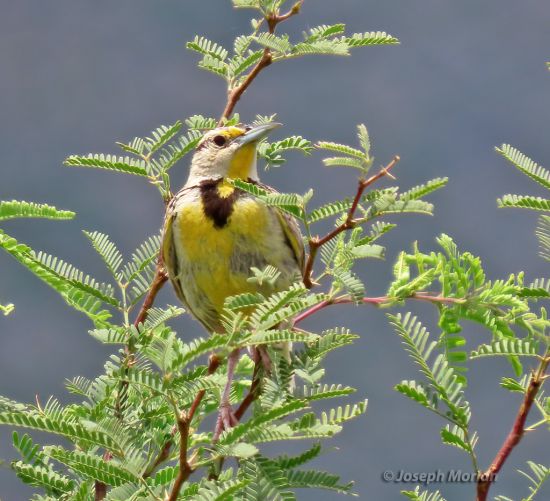Alternative name: Lilian's Meadowlark
- Sturnella lilianae
Identification
20–24 cm (7¾-9½ in). A medium-sized icterid.
Adults
- Yellow underparts
- Black "V" on breast
- White flanks with black streaks
- Upperparts are mainly pale with dark streaks
- A spread tail shows more white than in other North American Meadowlarks
- Long pointed bill
- Head has a white cheek and is otherwise striped with light brown and black
Distribution

Photo © by Stanley Jones
Davis Mountains, northwest of Fort Davis and southeast of McDonald’s Observatory, Jeff Davis County,, Texas, USA, 13 September 2021
From Arizona to eastern New Mexico, south-western Texas (west of Llano Estacado), and the western part of Mexico ending north of the Isthmus of Tehuantepec. Presumed a resident species.
There is no overlap in breeding range between Eastern and Chihuahuan Meadowlark. There is overlap with Western Meadowlark but they seem to segregate by habitat with Western found in more humid spots in the range of lilianae but reversed in the range of auropectoralis.
Taxonomy
This is a monotypic species[1].
Subspecies
Two subspecies are recognized[1].
- S. l. lilianae, "Lilian's Meadowlark": Northern Arizona to eastern New Mexico, south-western Texas, southern Sonora and north-western Chihuahua
- S. l. auropectoralis: Mexico (Durango and Sinaloa to Michoacan, Mexico and north Puebla)
Habitat
Desert grassland.
Behaviour
Feeding mostly on the ground with insects the most prominent source, but especially fall and winter supplemented with seeds and other vegetarian items.
Vocalisation
A series of 3-4 gently, downwards sloping elements. The highest pitch usually at the start of the first element and the lowest pitch at the end of the last element.
References
- Clements, J. F., T. S. Schulenberg, M. J. Iliff, T. A. Fredericks, J. A. Gerbracht, D. Lepage, S. M. Billerman, B. L. Sullivan, and C. L. Wood. 2022. The eBird/Clements checklist of Birds of the World: v2022. Downloaded from https://www.birds.cornell.edu/clementschecklist/download/
- Gill, F, D Donsker, and P Rasmussen (Eds). 2022. IOC World Bird List (v 12.2) DRAFT. Doi 10.14344/IOC.ML.12.2. http://www.worldbirdnames.org/
- Proposals for taxonomic change to the NACC 2022-C; C2 was the proposal leading to split of Chihuahuan Meadowlark
- Paper describing several aspects of the Meadowlarks in the region where Chihuahuan Meadowlark is breeding. (WE Lanyon - The Auk, 1962)
Recommended Citation
- BirdForum Opus contributors. (2024) Chihuahuan Meadowlark. In: BirdForum, the forum for wild birds and birding. Retrieved 27 July 2024 from https://www.birdforum.net/opus/Chihuahuan_Meadowlark
External Links
GSearch checked for 2020 platform.1




